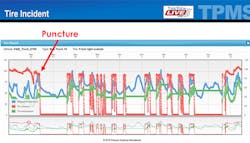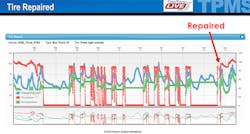PSI pumps up fleets’ tire data with new analytics platform
ATLANTA — For 25 years, Pressure Systems International (PSI) has been known for its automatic tire inflation systems (ATIS), which channel air from a reserve tank to trailer wheels to prevent underinflation, and possibly a blowout. One trailer blowout can cost $700 for the tire and service call. Then there’s the potential for late deliveries, drivers going over their hours of service, and a number of other reasons to triage tires.
After acquiring TST two years ago, PSI has also provided a tire pressure monitoring system (TPMS) called TireView to get ahead of the issue even earlier. This far less mechanically complex and reactionary solution alerts drivers when an issue arises and before a tire deflates to a critical level. And recently, at the 2019 North American Commercial Vehicle Show, the San Antonio-based company announced its most proactive, wide-reaching tool yet— the TireView LIVE data analytics platform.
Despite the similar name, don’t conflate this new product, which provides near omniscient view of a fleet's real-time and historical tire status, with a TPMS, which according to Jim Sharkey, vice president of global sales and marketing for PSI, this is “far beyond.”
“Tire pressure monitoring systems provide a snapshot in one point in time,” he said. “We’re looking for the big picture.”
The “big picture” TireView Live allows is the historical pressure and temperature data that might otherwise go unnoticed. A manager can sort by region, truck type, long haul vs. regional, and home in on what trucks are operating at low pressure. They set the thresholds, and the system alerts them when pressure falls below those limits. Repair shops can also get these alerts to generate work orders faster.
“The next opportunity for fleets to save money is to deliver real-time data to the office, where they can make faster and better-informed decisions, and let the driver focus on driving,” Sharkey said.
And it’s all represented visually to bring hidden or overlooked problems to light.
Here is an example:
A box truck suffered a puncture on March 25.
Over the next two weeks, the pressure fluctuated due to inflating when the truck started and the inflation system kicked in and decreasing when the truck turned off.
A manager can set the pressure threshold to avoid such issues, receiving an email alert, for example, when certain trucks fall below. This allows them to address small problems before they turn into big ones, like a blowout.
“Both ATIS and TPMS solutions are largely reactionary in nature,” said Jonathan Gravell, vice president of business development. “TireView LIVE is the tool that allows fleets to get ahead of problems before they become mission-critical."
All they have to do is ask the data platform the right question to uncover tires’ most hidden secrets.
One that Gravell offers is: “What is the percentage they ran underinflated and for how long?”
Gravell said a manager can place a value on that and generate custom reports, such as a training scorecard. These then help the drivers visualize the importance of checking the tires before heading out of the yard. PSI said that tires are the second highest fleet cost, behind fuel.
The results so far have been “drastic,” Gravell explained: “We’re seeing 60+% reduction in roadside calls with some of the [customers] we’re piloting with.”
The platform also doesn’t require an extra sign-in; it was designed to run as a widget on a third-party telematics dashboard. The sensor data actually goes to the third-party telematics platform first, and the TireView LIVE API requests that data from the cloud and takes control. The manager can see and manipulate the data via a widget on their telematics dashboard.
“The ability for our customers to customize their tire management solutions from a single systems provider is increasingly important,” Gravell said.
Because TireView LIVE is independent of the telematics, updates and improvements occur independently of telematics updates.
Currently, telematics partners include Road Ready by Truck-Lite, Phillips Connect Technologies, and FleetLocate by Spireon.
In 2020, PSI plans on releasing new temperature sensors for real-time readouts of wheel temperatures.
About the Author
John Hitch
Editor-in-chief, Fleet Maintenance, Senior Editor, Trailer-Body Builders
John Hitch is the editor-in-chief of Fleet Maintenance, where his mission is to provide maintenance management and technicians with the the latest information on the tools and strategies to keep their fleets' commercial vehicles moving.
He is based out of Cleveland, Ohio, and has worked in the B2B journalism space for more than a decade.
Hitch was previously senior editor for FleetOwner, and covers everything related to trucking and commercial vehicle equipment, including breaking news, the latest trends and best practices. He previously wrote about manufacturing and advanced technology for IndustryWeek and New Equipment Digest.
Prior to that he was editor for Kent State University's student magazine, The Burr, and a freelancer for Cleveland Magazine. He is an award-winning journalist and former sonar technician, where he served honorably aboard the fast-attack submarine USS Oklahoma City (SSN-723).



